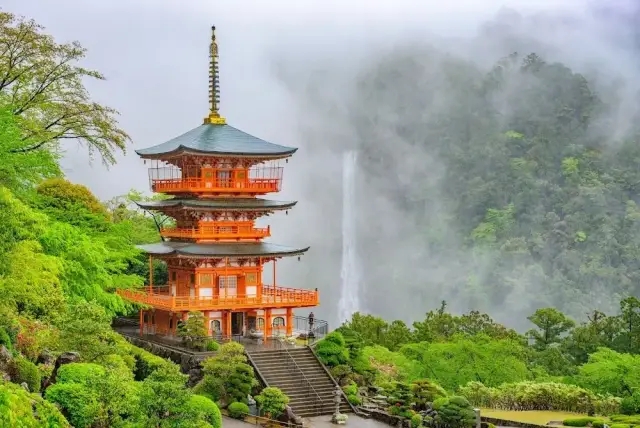https://www.dekitabi.com/itinerary/day-trip-kumano-nachi-tour
Daimonzaka: A Scenic Ascent

https://www.dekitabi.com/attraction/nakahechi-daimon-saka
Nestled in the heart of Japan’s Kii Peninsula, Daimonzaka is a renowned pilgrimage path that offers visitors a serene and scenic journey through lush forests. As you traverse this ancient trail, you’ll be enveloped by the tranquil beauty of the sacred Kumano region. Daimonzaka is more than just a pathway; it is an integral part of the Kumano Kodo pilgrimage routes, which have been traversed by spiritual seekers for centuries.
The ascent of Daimonzaka is marked by its beautiful stone steps, which lead you through dense, ancient cedar forests. This path provides an immersive experience into Japan’s natural and spiritual heritage. As you climb, the dense canopy of trees and the peaceful ambiance create a reflective atmosphere, ideal for those seeking both physical and spiritual enrichment.
Kumano Nachi Taisha Shrine: A Sacred Sanctuary

https://www.dekitabi.com/attraction/kumano-nachi-taisha
At the end of Daimonzaka, you’ll arrive at the illustrious Kumano Nachi Taisha Shrine. This sacred Shinto shrine is one of the three grand shrines of Kumano, collectively known as the Kumano Sanzan. Founded over a millennium ago, Kumano Nachi Taisha is renowned for its historical and spiritual significance. The shrine is dedicated to the deity of Nachi, and its hallowed grounds are a testament to Japan’s rich spiritual traditions.
The shrine complex is characterized by its stunning architecture, including a series of traditional wooden buildings that have been meticulously preserved. Visitors are drawn to the main shrine, which is beautifully adorned and offers panoramic views of the surrounding landscape. The serene atmosphere and historical resonance of Kumano Nachi Taisha make it a must-visit destination for those interested in Japan’s Shinto practices and ancient history.
Seigantoji Temple: Spiritual Heritage and Architectural Marvel

https://www.dekitabi.com/attraction/seiganto-ji-temple
Adjacent to the Kumano Nachi Taisha Shrine lies Seigantoji Temple, a prominent Buddhist temple that adds another layer of spiritual depth to the area. This temple, part of the Kumano Sanzan, is known for its significant role in the spread of Esoteric Buddhism in Japan. Seigantoji Temple’s history dates back to the 6th century, and it remains an important site for Buddhist worship and pilgrimage.
The temple’s architectural design reflects traditional Japanese Buddhist aesthetics, with elegant wooden structures and serene gardens that invite contemplation. Visitors often explore the temple grounds to experience its spiritual ambiance and appreciate its historical architecture. Seigantoji Temple offers a tranquil retreat from the hustle and bustle of modern life, making it an ideal spot for introspection and spiritual growth.
The Nachisan Seigantoji Temple Three-Storied Pagoda: A Symbol of Sacred Architecture

https://www.dekitabi.com/attraction/seiganto-ji-temple-sanjuno
A highlight of Seigantoji Temple is the Nachisan Seigantoji Temple Three-Storied Pagoda, a striking example of traditional Japanese pagoda architecture. This pagoda is one of the most iconic features of the Kumano Nachi area and holds significant cultural and historical importance.
Standing proudly amidst the lush greenery, the three-storied pagoda is renowned for its elegant design and intricate craftsmanship. Each level of the pagoda is adorned with detailed carvings and traditional motifs, reflecting the artistic prowess of the period in which it was constructed. The pagoda not only serves as a symbol of Buddhist teachings but also as a visual masterpiece that captivates visitors with its beauty and historical significance.
Visiting Tips for a Memorable Experience
When planning your visit to Daimonzaka, Kumano Nachi Taisha Shrine, Seigantoji Temple, and the Nachisan Seigantoji Temple Three-Storied Pagoda, consider the following tips to enhance your experience:
- Best Time to Visit: The best times to visit are during the spring and autumn months when the weather is pleasant and the natural scenery is at its most vibrant. Spring brings blossoming flowers, while autumn showcases stunning foliage.
- Dress Comfortably: Wear comfortable shoes suitable for walking and hiking, especially if you plan to explore Daimonzaka. Dress in layers to accommodate varying weather conditions.
- Respect Local Customs: Be mindful of local customs and traditions, especially when visiting sacred sites. Respect the rules of the shrine and temple, and observe quiet and respectful behavior.
- Photography: While photography is often permitted, check for any restrictions at each site to ensure you’re following local guidelines.
Conclusion
Daimonzaka, Kumano Nachi Taisha Shrine, Seigantoji Temple, and the Nachisan Seigantoji Temple Three-Storied Pagoda offer a rich tapestry of spiritual and historical experiences. Whether you’re drawn to the scenic beauty of Daimonzaka, the spiritual depth of Kumano Nachi Taisha, the architectural elegance of Seigantoji Temple, or the iconic pagoda, these sites provide a profound connection to Japan’s cultural and religious heritage. Embark on a journey to these sacred sites to immerse yourself in the tranquil and awe-inspiring world of Japan’s spiritual legacy.


Leave a Reply